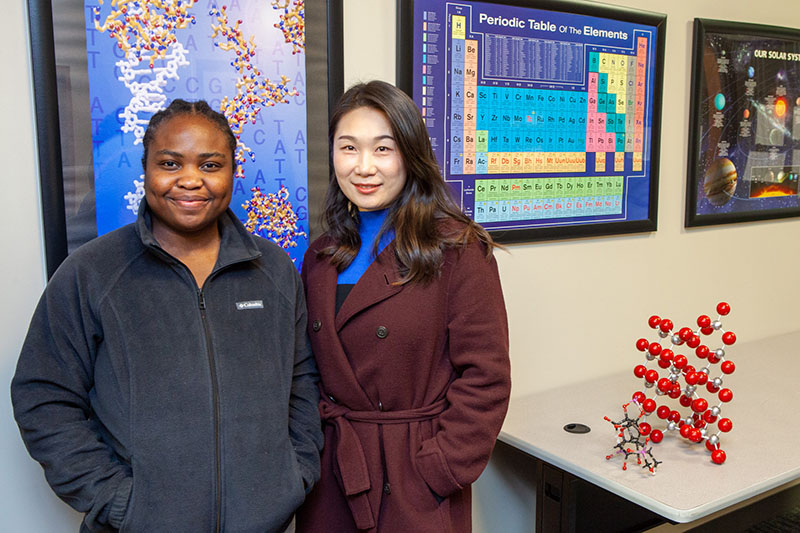- Apply
- Visit
- Request Info
- Give
Biochem student publishes 'cheminformatics' paper with mentor
Written by by Lucinda Weiss
Published on December 15, 2022

It’s uncommon for undergraduate students to publish their research in a scientific journal. But junior biochemistry major Djenerly Massena has done just that, co-authoring a paper with her faculty mentor and lead author, Kedan He, professor of physical sciences. Their paper, “Examining unsupervised ensemble learning using spectroscopy data of organic compounds,” appeared online in November in the Journal of Computer-Aided Molecular Design.
Massena has done research with Professor He since spring 2021. Her skills as a biochemistry major and computer science minor were just what He was looking for to help with a complex computational chemistry project.
“Recruiting undergraduate students for my research projects is a challenge, as it comes with a stiff learning curve,” said He, citing Massena’s tenacity. “It’s very lucky for me to have a student spend this much time on it.”
For Massena, it was fun. “It keeps me learning—it gets me excited,” she said.
Their research in a subfield of computational chemistry called cheminformatics examined a complex data problem: how to find the best choice of algorithm to analyze data on organic chemical compounds and identify new designer drugs. Designer drugs “are emerging at an alarming rate and often without time for adequate experimental determination of their pharmacological profile,” the authors wrote.
Designer drugs are similar to controlled substances, which have been identified experimentally, but they are not regulated because they are, by definition, new compounds. Identifying key patterns from the spectral datasets of the compounds could help pinpoint them, however, even if they are not a 1:1 match with known chemicals.
Massena and He used a research tool, the ensemble cluster selection method, to identify and retrieve detailed information on new designer drugs. Clustering data to identify patterns is what a retailer does in collecting data on online shoppers and using the pattern of their choices to target advertising to them, He noted. She likened ensemble clustering to having a committee of experts rather than one person offer a solution to a problem.
Within ensemble clustering, the researchers identified an algorithm known as the “Bagging” method as the most robust way to analyze the dataset, particularly where the sample size is relatively small. Their sample was not huge, He said, involving 930 subject compounds.
Because computational research requires high computing power, He has sought collaboration through a consortium by the name of “MERCURY” that fosters shared computing and encourages undergraduate research.
In 2018 she joined MERCURY, the Molecular Education and Research Consortium in Undergraduate Computational Chemistry. It provides its members, 47 faculty and their students from around the country, networking through summer conferences and a resource that their mostly undergraduate home institutions lack—high-performance computing. The members have access to a supercomputer housed at Clemson University, supported by a National Science Foundation grant to the consortium.
He and Massena attended a MERCURY conference last summer at Furman University in South Carolina, where Massena presented their research and they worked with other computational chemists to find new research strategies. In a recent paper published by the American Chemical Society, He and several other MERCURY faculty described how consortium investigators have trained 888 undergraduates in computational chemistry over the past 20 years, 75 percent of them women or students of color. The MERCURY researchers also have published 357 papers, or 1.7 papers per faculty member per year, which is 3.4 times greater than the usual rate at an undergraduate institution.
He, the only computational chemist at Eastern, is competing for a spot next summer at a Department of Energy (DoE) national laboratory, perhaps Oak Ridge or Brookhaven, where she would conduct research and Massena would intern. She will give what she described as an “elevator pitch” on their research at a workshop on Jan. 10 through the Sustainable Research Pathways program, which connects university student/faculty teams from under-represented groups with DoE scientists.
Besides support from MERCURY’s connections, He said her research is also supported by cheap, readily available cloud computing resources, by travel grants and the Undergraduate Research Creative Activity Fellowship program at Eastern and by an AAUP research grant.
For Massena, a native of Haiti who now lives in Derby, CT, the opportunity to connect with other computational chemists has been satisfying. Her career goal, still uncertain, she said, is to be either a neurosurgeon or a research physician.


